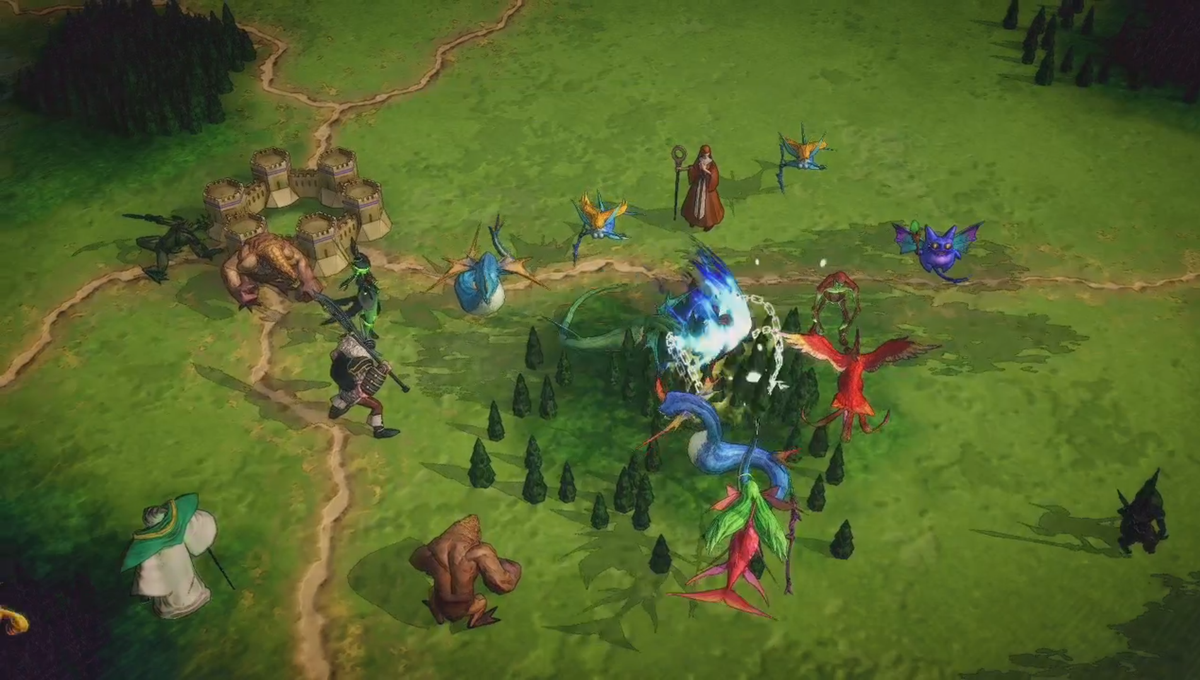
It’s no question that a united nation is a stronger nation. That doesn’t mean that everyone living there has to share the same beliefs, opinions, lifestyles, etc. In fact, that diversity can very well be what helps make that nation stronger. Unfortunately, there are those who believe that all must be united under one group, and that is one of the ways that wars can be started. In Brigandine: The Legend of Runersia, that’s essentially the premise of the game. You choose one of six nations and aim to conquer all of Runersia. Can you plan strategically enough to succeed? Or will you fall to one of the rival nations with the same goal in mind?
Brigandine: The Legend of Runersia tells the story of the land of Runersia and how it became what it is today. There’s a lot to cover, but I’ll give a brief overview. Long ago, five leaders acquired powerful mana stones called Brigandine, and each set out to create their own nations founded by their own beliefs. Each Brigandine represented a trait such as ego, sanctity, justice, glory, and freedom. A sixth nation also formed without the help of a Brigandine, but still managed to become a powerful force. Along with the discovery of these mana stones, the land was constantly being showered with mana, which led to mankind learning to harness it for their own uses, whether they be good or bad.

The six nations available are the United Nations of Mirelva, led by pirate captain Stella Hamett, the Norzaleo Kingdom, led by prince Rubino, the Republic of Guimoule, led by the president’s daughter Eliza Uzala, the Shinobi Tribe, led by the chief’s daughter, Talia, the Mana Saleesia Theocracy, led by the knight Rudo Marco, and the Holy Gustava Empire, led by Tim Gustav. Each leader has their own starting knights, monsters, bases, and mana reserves. This means that wherever you start, you’ll have to figure out the best way to begin your conquest. I personally opted for Stella and the United Nations of Mirelva; they’re pirates, how could I resist? For example, Stella starts with her father, Ginny, longtime companion Pluto, and mysterious robot Umimaru as her knights, along with a small collection of beginning monsters to command.
The gameplay is broken up into two phases: the organization phase and the attack phase. During the organization phase, you can use mana reserves to summon monsters to add to your troops, change equipment, alter the monsters in the troops, go on quests, change classes of units, and order troops to move to different bases. Each nation has a starting mana reserve and a designated amount that they’ll receive at the beginning of each organization phase. When you want to summon monsters, you must pay attention to the mana cost of those monsters, along with their mana upkeep cost. Every turn you must pay upkeep mana costs for the monsters you’re commanding, but thankfully, unless you go crazy, you shouldn’t run out of mana ever. Along with mana cost, each troop leader has a magic pool that shows how much magic they have to command monsters. Basically, this means that each monster also has a magic cost that takes up space in that mana pool. This is the limit to what monsters you can gather in one troop. For example, if your current monsters take up 210 magic of the 250 available in a knight’s magic pool, then you can only add monsters with a magic cost of 40 or less. This forces you to think carefully on what monsters you’ll comprise your team of. The fact that different bases have different monsters available to summon also impacts your decisions as well. Do you go for more small creatures? Or do you aim for fewer strong beasts? The choice is yours.
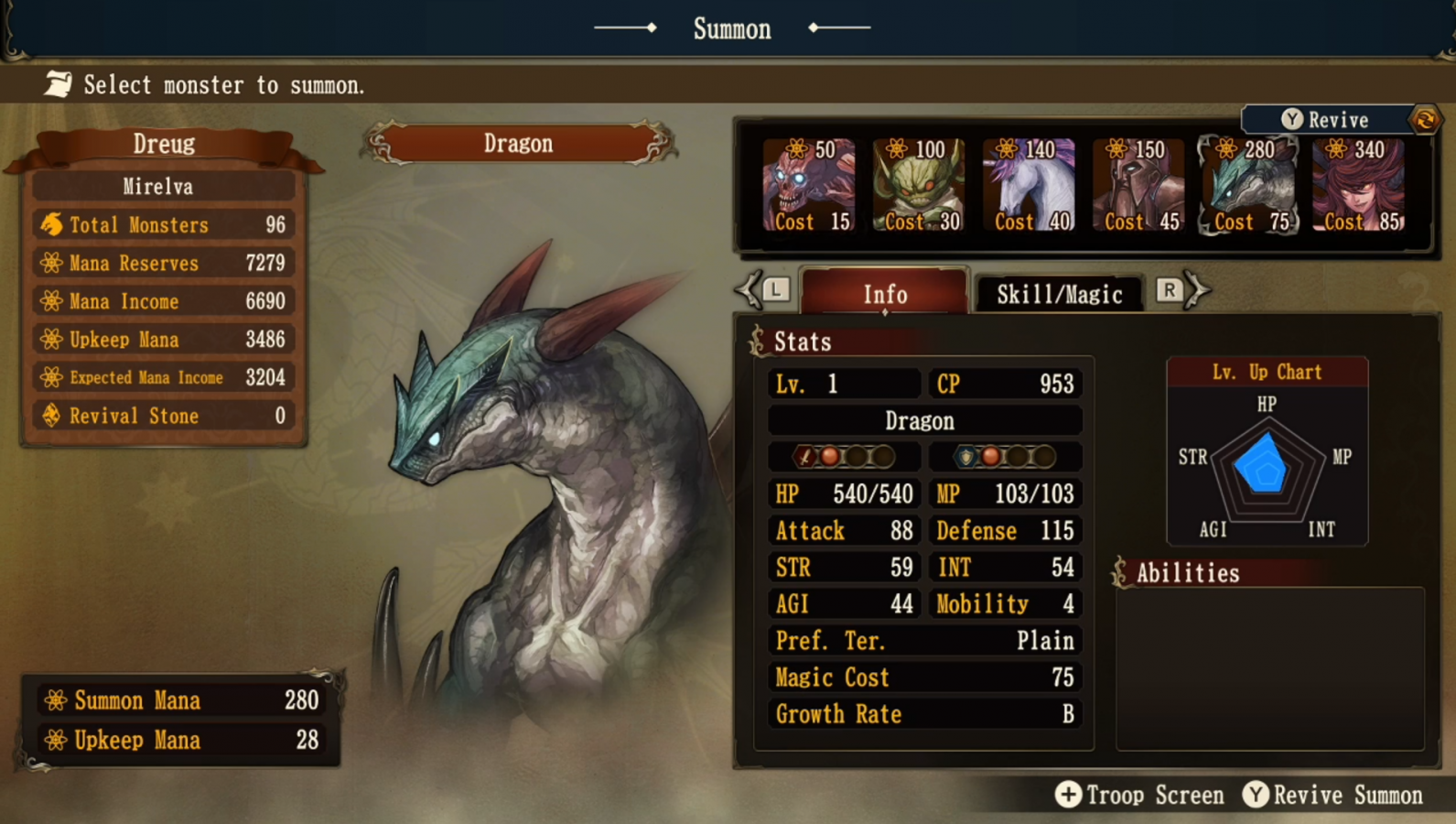
Class changes are additional ways to make your units more powerful as they level up. When reaching level ten, you can upgrade that unit to the next rank of their current class, resulting in their stats increasing and sometimes adding new moves to their arsenal. The downside is that their magic cost goes up, so if you upgrade them, make sure you have enough space in the magic pool for them to stay in that troop. Not paying attention to that can really screw you up. I didn’t pay attention once and had to rearrange several troops in order to keep that monster in the fight somewhere. If you’ve fulfilled certain requirements, you can potentially completely change the class of a unit if you want. This can allow you to bring moves from one class into a class that doesn’t normally have those moves if that unit has a high enough proficiency level (that levels up by fighting). Make sure you pay attention to the character’s stats before swapping classes to verify that the moves you want to transfer will actually transfer.
Quests are interesting little additions that can help level up knights and monsters without combat. You’ll typically have the choice between three quests and a training grounds visit at each base. The quests show you the odds of success depending on who you send, along with the potential rewards for success. Along with experience for the troop that goes, you may also acquire some new gear to equip to your knights, such as swords, armor, etc. The one downside to quests is that if you send a troop on a quest, then they can’t participate in battle that turn. This means that you should only go on quests if you don’t plan on using said teams to take over any bases in the immediate future. The same thing can be said of moving from base to base; if you’ve moved any troops in a turn, they have to wait until the next turn to attack. It’s a bit of a bummer, but it makes sense. Everyone needs rest sometimes, right? You can move troops as far as you’d like as long as you have an open path between bases that you control. This means that the more you’ve taken over, the more range you have to move around. I love that it’s like an extra bonus for successfully expanding your nation.
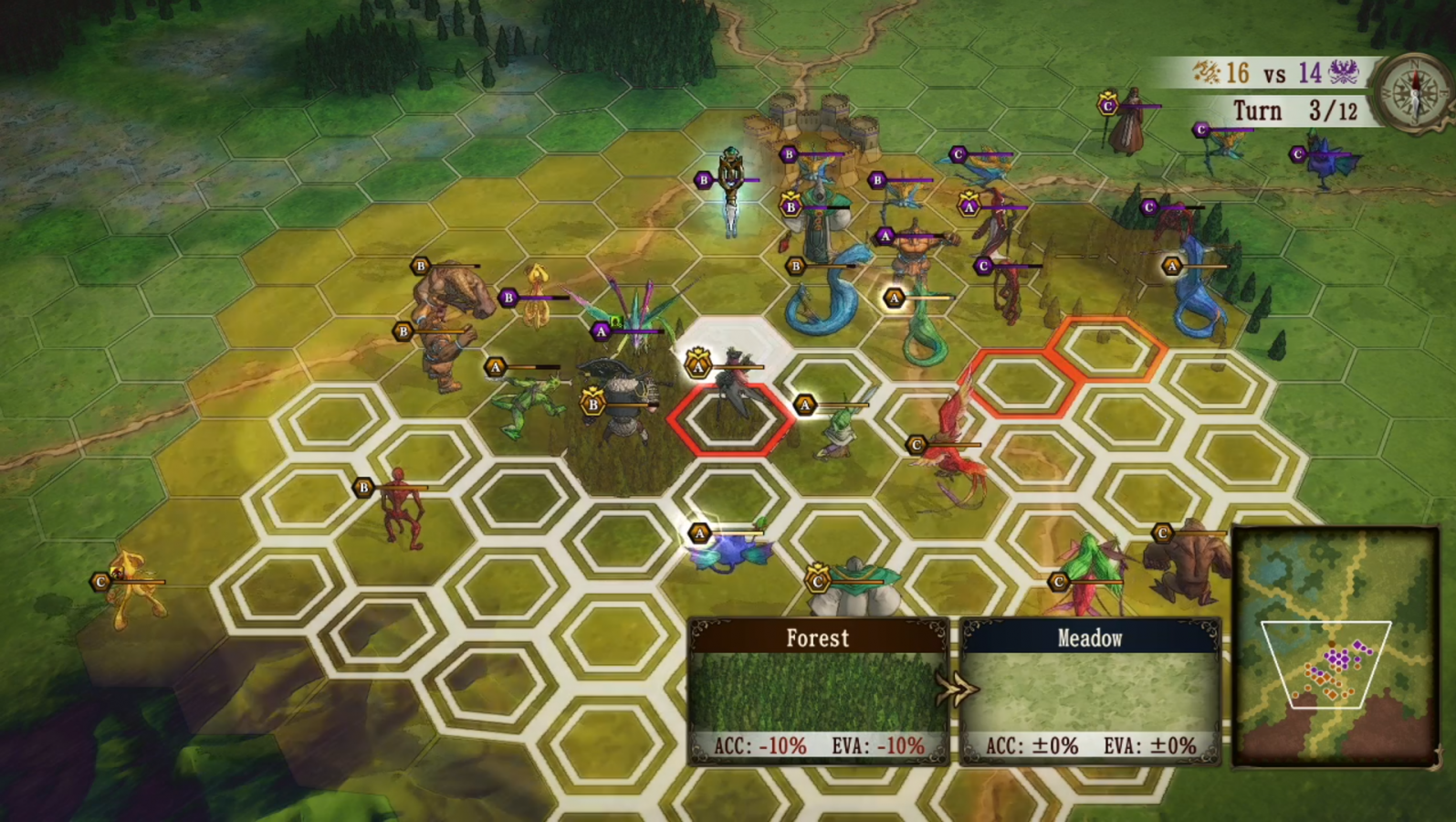
After the organization phase, we have the attack phase. This one is fairly straightforward: this is where you choose what bases you want to attack and what troops you want to send there. Before doing so, you need to keep three things in mind. First, you can only attack bases adjacent to the base a troop is currently in. Second, you can send as many troops as you like to attack a base, but only three of them can partake in the battle. You get to choose which three, but don’t think that sending seven troops means that seven troops will be under your control on that battlefield. Finally, you need to look at the current power of your troops compared to the power of the enemy troops in the bases you’re targeting. I’m not saying that you can’t win with a lower power value, but it’s better to make sure you’ve got the advantage before making your move. The organization phase is crucial in preparing your troops for some hard-fought battles.
When troops attack, you’re taken onto the battlefield which is laid out in a hexagonal grid format on top of the environment. You may be fighting in roads, meadows, forests, mountains, lakes, etc., and those are important to take into account. Each unit has preferred environments to fight in, which improve their accuracy and movement for as long as they reside in them. The opposite effect occurs for environments that they don’t fare well in. For example, rangers will thrive in forests, while sea serpents do their best work in the water. At the same time, your knights might not do too well up in the mountains or when trudging through a swampy area. On that note, some units won’t even be able to travel through certain environments, which can hinder their movements for some time. Units with sky preferred have no bonuses or penalties, no matter where they are, which is a nice neutral ground.
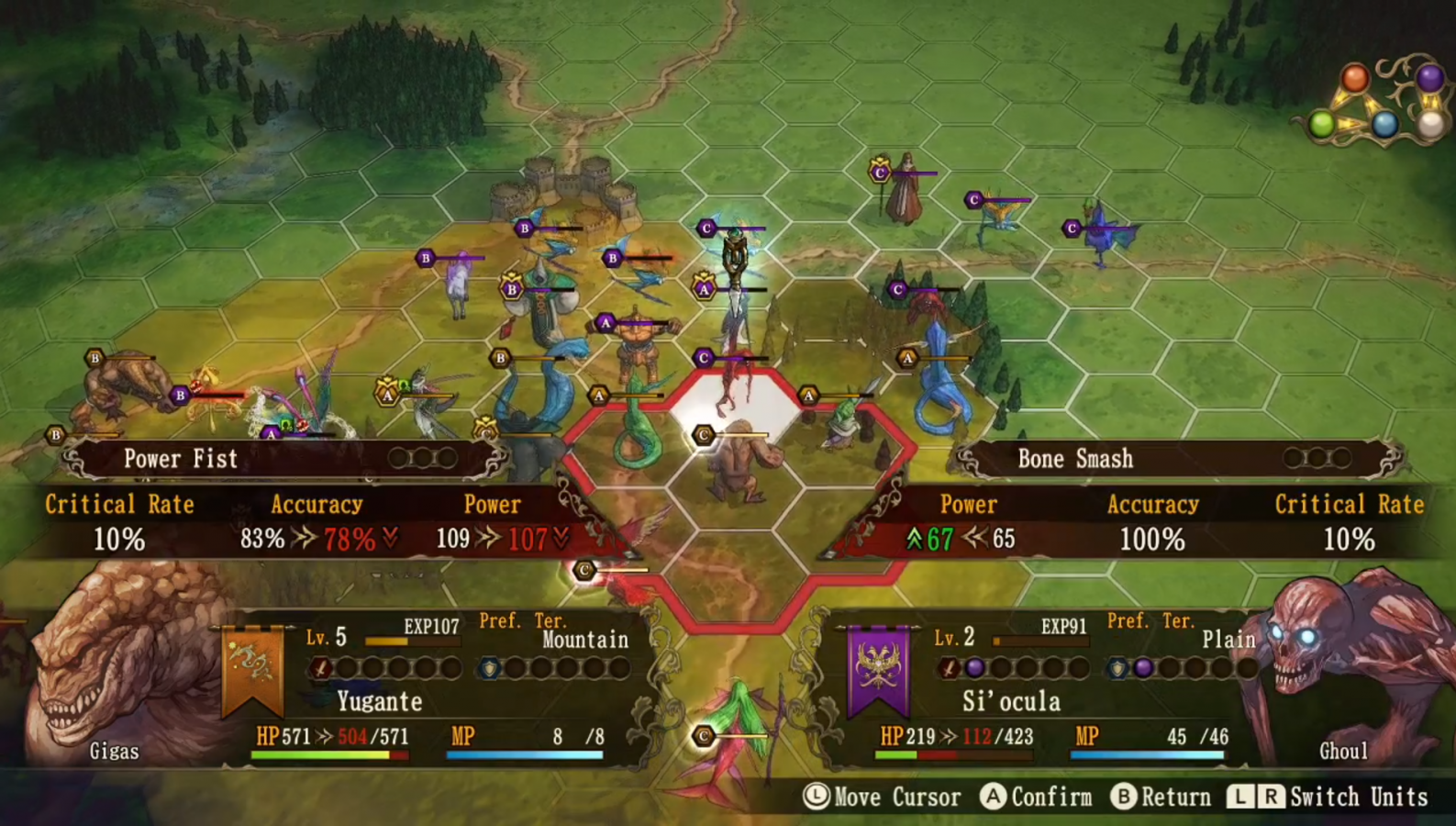
The battles take place in turn-based combat, with the order based on the levels of the troop leaders. Higher levels go first, and it proceeds from there. When a knight goes, their troop members take their turns immediately after them. You can move a unit a certain number of spaces, indicated by which hexagons light up on the grid when pressing move. After moving, depending on how close you are to enemies and what moves that unit has, you may or may not be able to attack right away. Every unit can attack an adjacent enemy after moving, while most have moves that can only be used on turns that they haven’t moved. Sure, you didn’t get to move this turn, but now you can unleash a more powerful attack. Basic attacks don’t cost any MP to use, but stronger moves do. These can be anything from firing an incredibly accurate arrow from afar, to shooting a line of fire through a line of three hexagons, to swinging and damaging every unit within one hexagon of the attacking unit. In addition to doing more damage, these stronger skills may also add extra effects such as poison, faint (prevents them from performing actions this turn), and more.
Two crucial aspects to consider when attacking are the accuracy of the attack and how much damage can be done to both sides. Yes, accuracy is important, and your characters can and will miss some attacks. Also, when any unit attacks, as long as the target doesn’t die, they will immediately counterattack. Just like with the initial attack, the counterattack can miss. You will have some frustrating moments when you can deal some massive damage to a foe or even kill them, and they end up missing. It hurts so much, and you get punished for it when your target smacks you back and potentially beats you up on their turn instead. It’s rough, but it’s part of the strategy, and you’ll have to learn to adapt to it. Not really a big surprise since this is a turn-based, strategic combat game.
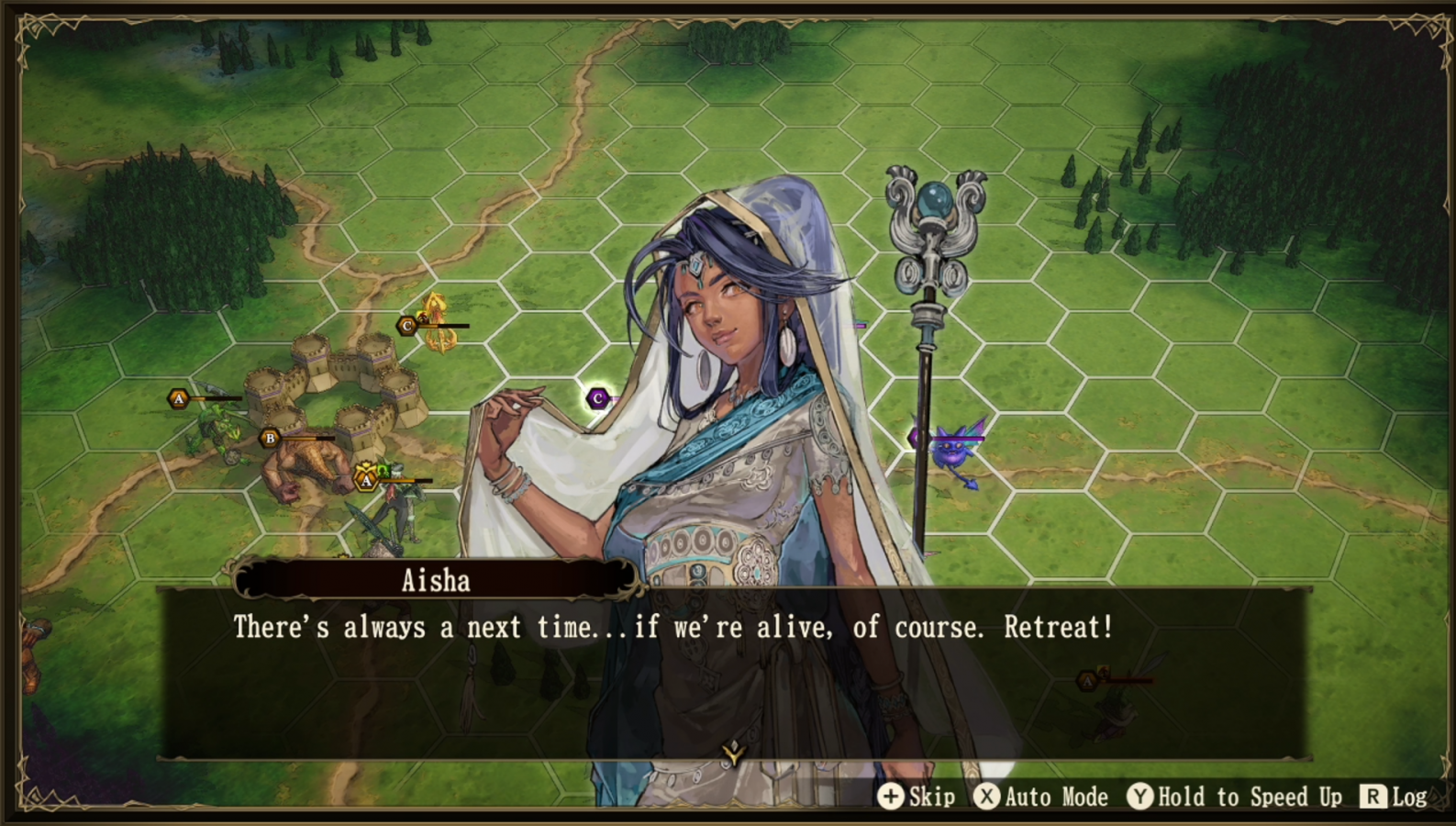
You win battles through a combination of defeating troop leaders and/or forcing them to retreat when they’re at a disadvantage. Defeating the troop leader forces them to retreat, possibly leaving some of their remaining monsters behind. Any abandoned monsters can be recruited to your troops during the next organization phase. After discovering that targeting troop leaders can eliminate the threat of their entire troop, I decided to target them as much as possible. Cutting off the head of the snake is the best way to kill it after all. If they are defeated, that leader has to recover during the next organization phase and is unable to battle. If they preemptively retreat, they can fight on the next turn since they haven’t been wounded as badly. That being said, the same circumstances can apply to your knights, so be careful during battle, and protect your leaders no matter what.
As your take over bases and expand your nation, you’ll trigger some story events that are told through screenshots and dialogue. The art style used is reminiscent of games like Fire Emblem, and I love it. The characters and environments look gritty yet wonderful at the same time. On the battlefield, they take a more colorful and cartoon-like look, but that fits better in that setting. Not having the exact same styles everywhere is refreshing, and it made me feel like I was balancing two different types of games back to back. Learning more about the characters and what drives them is fascinating, especially since I never expected Stella to go through the arc that she did. I won’t spoil anything, but I was pleased. Alongside the story events, when you’ve completely wiped out a rival nation, you’ll get aftermath sections that explain what happened to their leaders when their respective nation collapsed. It ties up loose ends to an extent, and I’m glad it wasn’t treated like “they’re gone, let’s move on and pretend they didn’t exist.” Oh, and fair warning, your story doesn’t end after wiping out the other five nations. There’s something more, but I’ll leave that for you to experience.
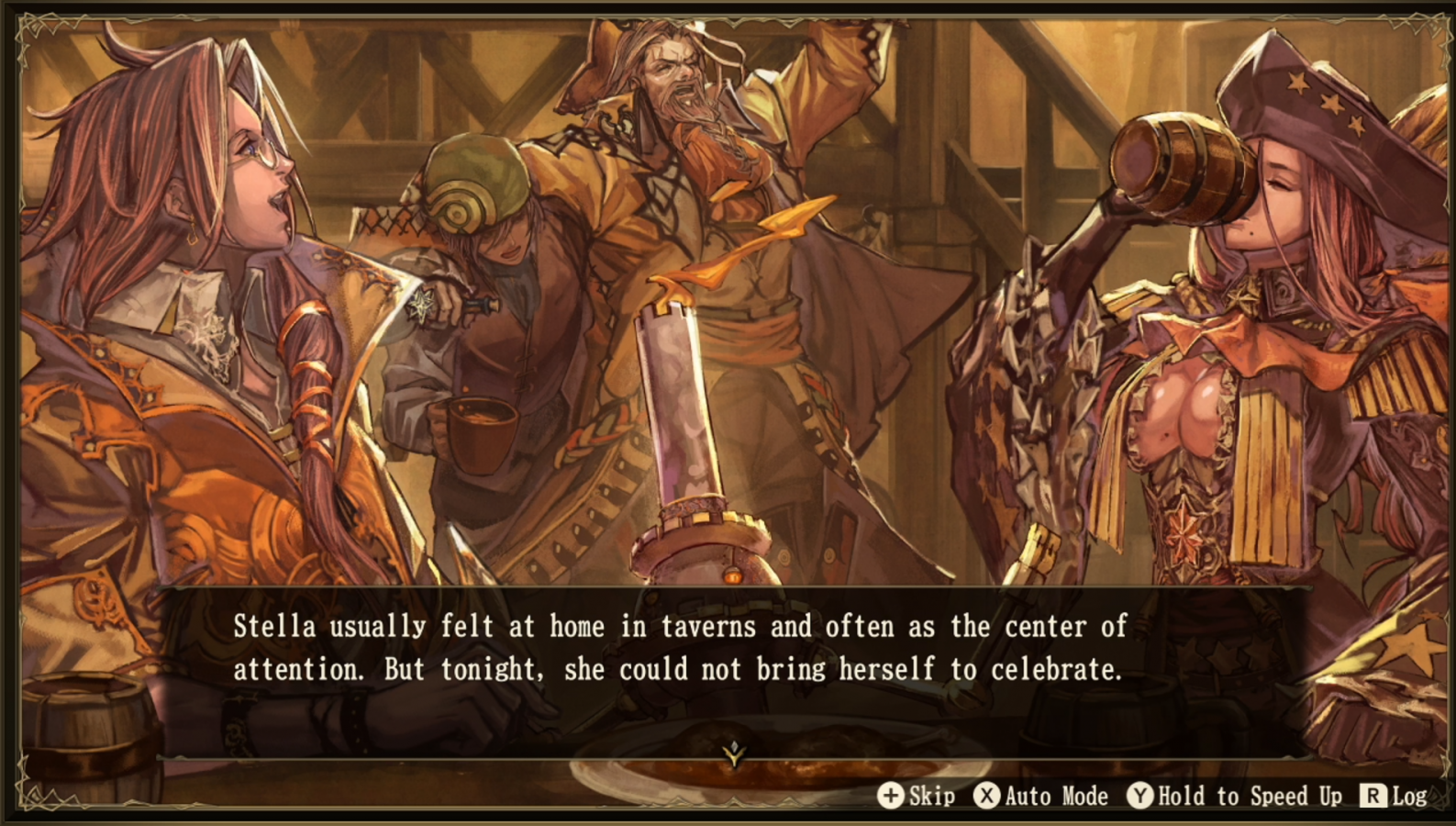
After completing the campaign once, you’ll unlock the Alternative Chapter. This is essentially a challenge mode where you aim to unite Runersia again, but this time you form your own custom nation comprised of one nation leader, about ten knights, and a collection of starting monsters. You and your rivals all start in one base, and you move on from there. As an added challenge, you have goals that you need to reach by certain points in order to keep progressing. If the campaign wasn’t tough enough, now’s your chance to up the ante. Overall, Brigandine: The Legend of Runersia features great turn-based, strategic combat laid out on hexagonal grids. With an interesting story, fascinating characters, and the way you approach your conquest being left up to you, you’re sure to have a great yet challenging time.
Brigandine: The Legend of Runersia
Great
Brigandine: The Legend of Runersia is a wonderfully crafted grid-based strategy game with plenty of planning needed. Some battles will be tough, but winning is rewarding every time. There are times when you'll be frustrated by your units missing attacks while the enemy beats you down, but that just forces you to adapt.
Pros
- Combat requires strategic thinking and planning
- Slowly building up and expanding your nation feels empowering
- Characters and their stories are fascinating
- Alternate Chapter gives you an extra challenge
Cons
- Accuracy is rough to navigate at times, even missing at high percentages
- Final boss can be pretty rough if you aren't prepared enough
